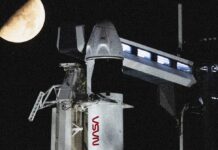On December 3, humanity suddenly had information at its fingertips that people have wanted for, well, forever: the precise distances to the stars.
“You type in the name of a star or its position, and in less than a second you will have the answer,” Barry Madore, a cosmologist at the University of Chicago and Carnegie Observatories, said on a Zoom call last week. “I mean …” He trailed off.
“We’re drinking from a firehose right now,” said Wendy Freedman, also a cosmologist at Chicago and Carnegie and Madore’s wife and collaborator.
“I can’t overstate how excited I am,” Adam Riess of Johns Hopkins University, who won the 2011 Nobel Prize in Physics for co-discovering dark energy, said in a phone call. “Can I show you visually what I’m so excited about?” We switched to Zoom so he could screen-share pretty plots of the new star data.
The data comes from the European Space Agency’s Gaia spacecraft, which has spent the past six years stargazing from a perch 1 million miles high. The telescope has measured the “parallaxes” of 1.3 billion stars—tiny shifts in the stars’ apparent positions in the sky that reveal their distances. “The Gaia parallaxes are by far the most accurate and precise distance determinations ever,” said Jo Bovy, an astrophysicist at the University of Toronto.
Best of all for cosmologists, Gaia’s new catalogue includes the special stars whose distances serve as yardsticks for measuring all farther cosmological distances. Because of this, the new data has swiftly sharpened the biggest conundrum in modern cosmology: the unexpectedly fast expansion of the universe, known as the Hubble tension.
The tension is this: The cosmos’s known ingredients and governing equations predict that it should currently be expanding at a rate of 67 kilometers per second per megaparsec—meaning we should see galaxies flying away from us 67 kilometers per second faster for each additional megaparsec of distance. Yet actual measurements consistently overshoot the mark. Galaxies are receding too quickly. The discrepancy thrillingly suggests that some unknown quickening agent may be afoot in the cosmos.
“It would be incredibly exciting if there was new physics,” Freedman said. “I have a secret in my heart that I hope there is, that there’s a discovery to be made there. But we want to make sure we’re right. There’s work to do before we can say so unequivocally.”
That work involves reducing possible sources of error in measurements of the cosmic expansion rate. One of the biggest sources of that uncertainty has been the distances to nearby stars—distances that the new parallax data appears to all but nail down.
In a paper posted online December 15 and submitted to The Astrophysical Journal, Riess’s team has used the new data to peg the expansion rate at 73.2 kilometers per second per megaparsec, in line with their previous value, but now with a margin of error of just 1.8 percent. That seemingly cements the discrepancy with the far lower predicted rate of 67.
Freedman and Madore expect to publish their group’s new and improved measurement of the cosmic expansion rate in January. They too expect the new data to firm up, rather than shift, their measurement, which has tended to land lower than Riess’s and those of other groups but still higher than the prediction.
Since Gaia launched in December 2013, it has released two other massive data sets that have revolutionized our understanding of our cosmic neighborhood. Yet Gaia’s earlier parallax measurements were a disappointment. “When we looked at the first data release” in 2016, Freedman said, “we wanted to cry.”
An Unforeseen Problem
If parallaxes were easier to measure, the Copernican revolution might have happened sooner.
Copernicus proposed in the 16th century that the Earth revolves around the sun. But even at the time, astronomers knew about parallax. If Earth moved, as Copernicus held, then they expected to see nearby stars shifting in the sky as it did so, just as a lamppost appears to shift relative to the background hills as you cross the street. The astronomer Tycho Brahe didn’t detect any such stellar parallax and thereby concluded that Earth does not move.








